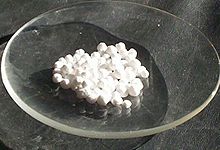Know Your Remedies: Bromium (Brom.)
 Bromine is chemical element from the halogen group. It is corrosive and toxic and at room temperature presents as a reddish brown liquid.It was
Bromine is chemical element from the halogen group. It is corrosive and toxic and at room temperature presents as a reddish brown liquid.It was
used extensively as a fire retardant but less so since it was discovered
that its use also contributes to depletion of the atmospheric ozone
layer. When prepared as a homeopathic remedy, Bromine is known as
Bromium. It is noted for conditions aggravated by the heat, improved by
sea air, and in which swollen stony glands are present.
Common Uses
When the remedy matches the symptoms, Bromium has the ability to treat
the symptoms of allergy, asthma, croup, diphtheria, goitre,
laryngospasm, swollen and hardened glands, orchitis, ovarian cysts, tumours.
From the Old Masters
Nash says:
An element proven and arranged by Hering and an important remedy in laryngeal affections. Also in scrofulous and tubercular affections of the glands. It is well known to act best on persons with light blue eyes, flaxen hair, light eye-brows, fair, delicate skins, red cheeked scrofulous girls. It will be remembered how almost exactly opposite, so far as temperament is concerned, is Iodine, which is also one of our chief anti-scrofulous remedies. In glandular affections, three remedies that are not as often thought of as they perhaps should be, are Carbo animalis, Conium and Bromine; in all three the glands are stony hard with a cancerous tendency. In Bromine the pains are not characteristic, but with Conium and Carbo animalis they are lancinating, cutting or burning, more like cancer pains.
In diphtheria, where it has done some wonderful work, the membrane first forms in the bronchi, trachea or larynx, running upward, just the opposite of Lycopodium, which often forms first in the nose and runs downward.
In membranous croup, there is great rattling of mucus like Hepar, but no expectoration. There seems to be great danger of suffocation from accumulation of mucus in larynx (in bronchi, Ant. tart.).
Sensation of cobweb in face. (Bar., Graph. and Borax).
Fan-like motion of alæ nasi (Ant. t. Lycop.).
Hypertrophy of heart from gymnastics (Caust.).
Membranous dysmenorrhœa (Lac can.).
Lippe says:
MIND AND DISPOSITION.
Cheerful mind ; desire for mental labor.
Low-spirited, and out of humor.
Crying and lamentation, with hoarse voice.
GENERALITIES.
Excessive languor and debility, (worse after breakfast). Tremulousness all over.
CONDITIONS.
Aggravation in the evening till midnight ; in the warm room ; and when at rest.
Amelioration from motion, riding on horseback.
More suitable for persons with light hair and blue eyes.
Hering says:
MIND.
In evening when alone, felt as if he would see something if he should around ; as if some one were back of him.
Expects to see something jump around the floor.
Desire for mental labor, preceded by aversion to his own profession.
Crying and lamentations, with hoarse voice.
Great depression of spirits.
Low-spirited and out of humor.
TISSUES.
Swelling and induration of the glands.
Enlargement of thyroid, in persons with light hair, blue eyes and fair skin.
Acts better, though not exclusively in person with light hair and blue eyes.
Increased embonpoint.
Important
While above self-limiting or acute complaints are suitable for home treatment, see your healthcare provider if symptoms worsen or fail to improve. Chronic or persistent complaints, which may or may not be mentioned above, require a different treatment and dosage protocol so are best managed by a qualified homeopath for good results.
Sources:
Textbook of Materia Medica by Adolph Lippe M.D. 1886 Publishers: AJ.Tafel
Constantine Hering. 1877. Condensed Materia Medica. Publishers: Boericke and Tafel
E. B. NASH. 1899 Leaders In Homoeopathic Therapeutics. Publishers: Boericke and Tafel





